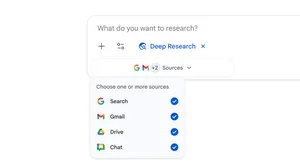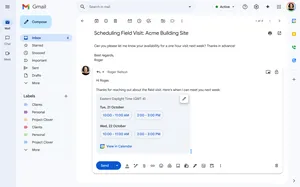Make the most of your day: 7 Google Calendar tips

Time is precious—especially when you’re working from home and balancing work and family. The less time you spend fussing with tasks like scheduling, searching for a meeting code, or switching from app to app, the more time you can spend on things that matter.
Google Calendar is filled with intuitive tools and tightly integrated with other G Suite apps—including Gmail, Meet, Drive, Contacts and Sites—to help you stay on top of your day-to-day schedule. Here’s a handful of tips, tricks and features that will help you plot a course for your day.
Find a meeting time that works for everyone
Childcare. Time zone differences. Other meetings. Finding a time when everyone can meet can feel like a tricky game of Tetris. With Google Calendar, you have a helping hand to figure out when someone’s availability intersects with yours.
Here’s how to do it: In Calendar, click on Search for people on the left, type in the name of someone you want to meet with. If they’re part of your work or school organization, you can select their name and see their calendar overlaid on yours. Pick an open time slot, fill in the meeting details, and click Save.
When you invite a guest to an event, a unique Google Meet code is automatically added (you can adjust this in Settings). And for G Suite customers, dial-in information is added in case someone joins from a phone.
Meet across time zones
Meeting with people in different regions adds complexity to scheduling. If you do it frequently—say your London-based company has offices in New York City or you have a weekly call with teams across the country—then it’s helpful to display multiple time zones directly on your calendar.
Click on the Settings icon and select Settings. Under Time zone, click the box to display a secondary time zone and choose your preferred time zone. To add multiple time zones, simply scroll to the World clock and click Show world clock. Selected time zones will show up on the left-hand side of the Calendar below the month view.
Stay attuned to others’ working hours
It’s important (courteous, in fact!) to be aware of others’ working hours when scheduling a meeting. We made it easy to set your own working hours, and see other people’s working hours.

To set your working hours, click the Settings icon in Calendar, then select Settings. Under General, click Working Hours, then check Enable working hours. Select the days and times that you work. This feature can be turned on or off on a computer, but not via the mobile Calendar app.
Now coworkers can see your working hours when they schedule meetings with you, reducing the likelihood of meetings popping up outside of your working hours.
If you’ll be out of the office, Calendar can automatically decline events during that time. At the top of your calendar, click the first date you’ll be out of office. In the event details box select Out of office, then choose the dates. Calendar will decline meetings scheduled over your out-of-office blocks and include a custom message. Coworkers will still be able to communicate with you in Google Chat or Gmail, but they’ll see an automated notification that you’re out of office when they start a chat or email to you.

Share your calendar
People are balancing more demands from both work and home, making it extra important to respect everyone's schedule. Adjust your default settings so people on your team or organization can view the full details of events on your calendar, rather than only seeing “free” or “busy.” This way, if someone wants to meet with you they can see whether you’re giving an important presentation that can’t be moved or simply having a virtual coffee chat that can be moved. This is especially helpful for people who have a lot of meetings and reduces back-and-forth emails about availability.
To share your calendar broadly or with specific people, go to the My Calendars section, hover over the calendar you want to share, click on More (the three vertical dots), then Settings and sharing. It’s helpful to share your personal calendar with your work account to make scheduling even easier for you.
You can always unshare your calendar or adjust permissions and visibility. Learn more about calendar sharing on our Help Center.
Control who sees what
You can change what others see about certain events. For example, you might want to keep a confidential meeting or telehealth appointment private. In Calendar, open the event that you want to update and click Default visibility. Choose the privacy setting for the event and click Save.
Organize your to-do list
Scheduling a task is a lightweight way to organize your to-do list in Calendar. To add a task to your calendar (these will only be visible to you), click on the Tasks icon on the right side panel. Select Add a task, give it a label or name, then add details and a date and time. You can also add tasks to your calendar from Gmail, Google Drive, or from a file in Docs, Sheets, or Slides—just look for the Tasks icon in the side panel, a column on the right side of these apps. Learn more on our Help Center.
Leave room for a breather
When you’re taking back-to-back meetings from home, it’s convenient to have a few minutes to prepare for your next meeting or even stretch. Set scheduled events to end five minutes early (events longer than a half hour will end 10 minutes early). In your Calendar settings window, scroll down to Event settings and click the Speedy meetings box.
We’ve found that even if a meeting is scheduled to end at, say, 4:25, it tends to run until 4:30. So instead of ending meetings early, start your meetings five minutes past the hour or half-hour. You might find that those extra few minutes make a real difference.
To learn more about how Google Calendar can help you make the most of your day, visit the Calendar Help Center.






